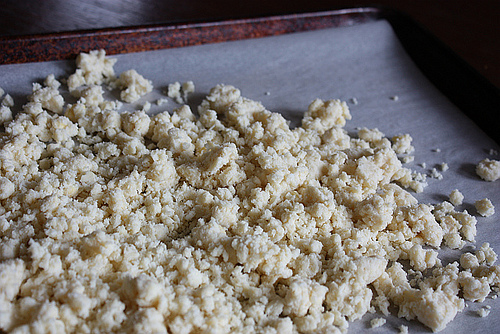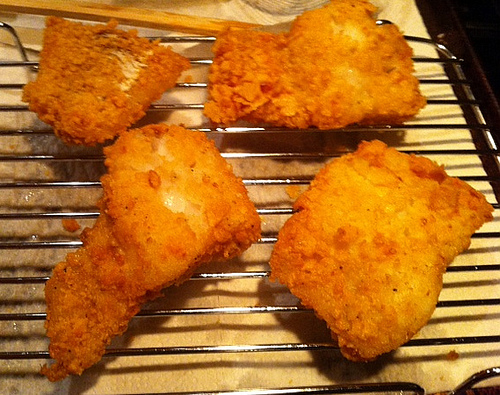Someone suggested Inez recently via a post comment that you can use the lees leftover from making tofu to make a soy version of panko. The tip stuck in my mind and I gave it a try the other day. If you’re not familiar with the lees, they are the solids that remain after you’ve pressed out the soy milk. Professional tofu makers have so much of it that they usually arrange for it to be hauled off to a nearby farm to be used as animal feed. But for home cooks who are small batching it, you can turn it into food for humans (you) to eat! Consider the lees a tofu byproduct bonus.
Soymilk lees, often called okara (their name in Japanese) are a great source of fiber and protein. In Asian Tofu, I have a number of recipes that use the okara, including croquettes, cookies and even a little fake meat. I didn’t think of turning okara into a gluten-free panko. It’s a brilliant idea and super easy to execute.
The photo at the top highlights how you can make flakes like oatmeal or cornflakes or crumbles like coarse ground cornmeal. If you’re not making your own soy milk and don’t have the lees leftover, you can buy them or get them for free from a tofu shop. Japanese markets may sell it in plastic bags near the refrigerated tofu section. It looks like this:
How did the soy panko work in cooking? Quite well. I fried fish with it last night and the crust was delicately crisp and nutty tasting. It didn’t brown as fast as regular panko bread crumbs which was rather nice because I’m always a bit harried when frying with panko, which browns relatively quickly. Actually, the thin tail piece got was extra good with the bits of soy panko. See below for how I fried with the panko.
RECIPE
Gluten-Free Soy Panko
6-8 ounces fresh or thawed soy milk lees
1. Position a rack in the middle of the oven and preheat to 300F.
2. Line a rimmed baking sheet with parchment paper or a nonstick baking mat (e.g, Silpat). Spread or scatter the lees out to cover the surface of the baking sheet. If you want flakes, press down on the lees with the palm of your hand to flatten them out to form a very thin layer. Otherwise, leave them as buff-colored nubs. On this baking sheet, I did half and half:
If you happen to find some intact beans, remove and discard them:
3. Slide the baking sheet into the oven and bake for 20 to 30 minutes. If you are making the crumbles, stir to break them up a bit every 10 minutes. With the flakes, leave them be until the 15 to 20 minute mark, when they should look parched, like a dry desert lake bed. When possible, use a metal spatula to turn it over. It’ll break up but that’s okay.
4. When the “panko” feels as if it has just a little bit of moisture left, turn off the oven. Leave for 10-15 minutes for the soy panko to finish drying out. It will feel somewhat like Styrofoam when done. Pull the baking sheet from the oven, and allow to cool. Crumble the soy panko up as needed. I broke the larger flakes up. Use or store in an airtight container or zip-top bag.
Frying with soy panko
For last night’s fried fish, I cut a 1-pound fillet into 3 by 4-inch pieces, about half the size of the palm of my hand. To absorb excess moisture, I dredged each piece of fish in regular flour (you can use cornstarch or tapioca starch, even rice flour for a full gluten-free treatment). Then I let it sit until the fish no longer looked like it was coated in white. Then I drizzled a tiny bit of soymilk over the fish, which turned the flour into a slightly sticky surface. (You could use beaten egg, which may actually work better; I was out of eggs.)
Finally, I coated the fish pieces in the soy panko, lightly pressing it into place. The fish was shallow fried in 350-375F oil. Some of the panko fell off (I think I should have used egg) but most of it stayed on the fish, forming a nice crust. After pulling the fish from the oil, let it rest on paper towel for a few seconds to blot away excess oil, then cool on a rack.
Baking with soy panko: Not great as it didn't brown much as a topping on a casserole-type dish. Maybe as a "Shake and Bake" type of application where the soy panko comes in contact with lot of fat so it can kind of fry.
How’s that for using the whole soybean?!
Other recipes where you could use gluten-free soy panko:
- Crispy shrimp coated with green rice
- Stuffed Crab Claws (a dim sum recipe on Asian Dumpling Tips)
- Kaffir Lime Fried Chicken






















Laura says
This is another one of your great ideas! I happen to have some okara in the refrig from making soymilk, and I was thinking about throwing it away or freezing it. This will be a great way to use it up for Friday's fish dinner. No one needs to know about my "secret" ingredient!!
Lori says
Brilliant! Thanks for the instructions. I am so excited to try making some soy milk and then using the lees. I've actually purchased okara from store before and now that seems expensive and silly when I can make my own! :O) Thanks!
maggie says
Hi Andrea. How would you know if soya beans for making tofu are non-GM? I love tofu, and I like the idea of making my own or buying an artisanal product. However, I tend to avoid commercial tofu as so many products contain GM soya nowadays. Thanks for any info!
ChinLin says
Hi Andrea. Could I email you about a school project I am doing? It's about vietnamese food and I would love your input. Thank you!
stella@raplica handbags says
when i try your panko its so amazing taste and looks so good.can you taste your recipe.i feel its a continental taste specially in fish fries...and i request you to please upload some other recipes that make so easy cooking
Chopinand @ ChopinandMysaucepan says
Dear Andrea,
The healthy soy panko might just negate the oils from the deep fry. Love the golden brown colour of the fish.
Andrea Nguyen says
OMG - it's a great new twist for Fish Friday. Yep, use that okara.
Andrea Nguyen says
I've looked at the okara at the store too as well as giant bins of it at tofu shops. Then, I remind myself that my freezer has bags of it already. ;D
Andrea Nguyen says
I buy soybeans that are labeled non-GMO or organic. Health food markets label their soybeans these days -- even the stuff in bulk. With the book project, I've taken to mail ordering soybeans from a single source: Fairview Farms in Iowa. Their Laura soybeans are terrific. Here's a link: http://www.fairviewfarms.com/
Andrea Nguyen says
I think you need oil to come in contact with the panko. It actually didn't take much oil. The key, I think, is to initially coat the fish pieces with some kind of flour or starch. That seals things up. I suppose you could toss the soy panko with oil, coat the fish with it, then bake. That may be a good workaround.
Inez says
Hi Andrea
I'm so glad you were able to run with my idea. To add more flavour to the okara, I sometimes stir a tbsp or 2 of soy sauce into it before drying in the oven, or add some stock powder or kelp pepper to the dried crumbs.
Inez
cv writing service says
Thisis very delicious food. You should try to cook it at home, it's really very simple.
maggie says
Thanks, Andrea. I'll look out for these.
TinCook says
Cool! I was planning on turning my okara into granola the same way.
Andrea Nguyen says
Inez -- THANK YOU for claiming the idea. Flavoring and coloring the okara before baking is yet another point of brilliance! You rock.
Andrea Nguyen says
I'm thinking you can maybe put the okara in that nifty tofu press you built! ;D
TinCook says
Heh, that press is very much a work in progress. I ended up having to add a couple of 'shims' to the follower plate because it wasn't wide enough and the edges weren't getting compressed enough. I made a batch of tofu today, and the shims expanded too much from all the hot whey and caused the follower to stick a little, so they need to be sanded down a bit.
I'm also thinking of making a collar for the box so I can ladle more curds in, like the old school tofu makers have for their settling boxes. My tofu blocks are coming out 1/2 to 2/3's the height of store bought.
TinCook says
The okara got spared a pressing and is parching in the oven for use as the panko and for granola.
Jodi says
I have been a fan of your blog for years and recently found out that I have a gluten intolerance - thank you for all of these very thoughtful posts on gluten-free Asian cooking products. It is so wonderful to know that my new diet does not mean a complete change in lifestyle 🙂
Andrea Nguyen says
My pleasure, Jodi. Thanks for commenting.
Dolt Gabi says
Good luck ,Great post,y love you!Thanks for the info it had cleared out too many things in my mind. Your recommendations are really good.
http://www.watermelonhealthbenefits.com
cheapnbajerseyssale says
Awesome!! Thanks so much for sharing!!!
resume writers says
Fatfree soybean meal is a significant and cheap source of protein for animal feeds and many prepackaged meals soy vegetable oil is another product of processing the soybean crop. For example, soybean products such as textured vegetable protein are ingredients in many meat and dairy analogues. Thanks.
argan oil sallys says
The breads used to make soft or fresh bread crumbs are not quite as dry, so the crumbs are larger and produce a softer coating, crust, or stuffing. The crumb of bread crumb is also a term that refers to the texture of the soft, inner part of a bread loaf, as distinguished from the crust, or skin. Thanks.
Gluten Free Panko Bread Crumbs says
Your recipe seems to be ausome .I admire the valuable information you offer in your message.I am very impressed to watching your article of Gluten free product.That is very authentic & fantastic. A gluten-free diet is the only medically accepted treatment for celiac disease the related condition dermatitis herpetiformis, and wheat allergy, but not gluten allergy.
gabriela says
Good luck ,Great post,love you!Thanks for the info it had cleared out too many things in my mind. Your recommendations are really good.
http://valeria.flamingstudiosgro.click2sell.eu